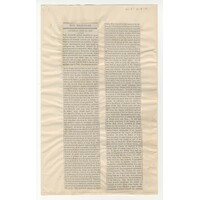Untitled (Bishop Gray and Rev. Long) (High versus Low Church) (despotic colonial bishoprics) (Gray's course)
Metadata
Untitled (Bishop Gray and Rev. Long) (High versus Low Church) (despotic colonial bishoprics) (Gray's course)
Publications & Reports
Bleek problematises Bishop Gray's "ecclesiastical despotism", typified by his authoritarian treatment of his subordinates and his attempt to make himself "independent of all lawful authority". Bleek claims Gray's behaviour contradicts Protestantism's first principles of religious liberty. He names Reverend William Long of Mowbray as a victim of Gray's despotism, characteristic of colonial bishoprics. After establishing a representative government in South Africa, the Church of England could no longer enforce a pervasive ecclesiastical jurisdiction in a secularising, multi-denominational Protestant land. It would now transform into a voluntary association, which aggrieved the Cape's Anglo-Catholic High Church faction. Gray could not force his subordinates to comply with willful orders, summon them to a Synod at his convenience, or enforce any punishment against them. He views Colenso and Long as his Low Church party antagonists. Bleek reviews Long vs Bishop of Cape Town (1863) before citing Gray's unilateral excommunication of Colenso in 1866 and his friction with Long as examples of his "ecclesiastical despotism". The Privy Council ultimately supported Long despite submitting to Bishop Gray's jurisdiction when accepting his office from Gray. Lastly, Natal "laymen" request Bishop Gray's resignation and Miss Burdett Coutts (Gray's principal patron) objects to Gray establishing an independent "South African Church", stating that a church not bound by the Church of England's Church law ceases to be Anglican (or even Protestant) and may backslide into Catholicism or Eastern Orthodoxy.
Printed newsprint glued on paper
12/07/1866
Two cut out columns of newsprint text, positioned vertically parallel, pasted onto a plus-sized A4 unlined sheet with visible warping. No title was subsequently handwritten onto the mount/paper backing.


Contributions